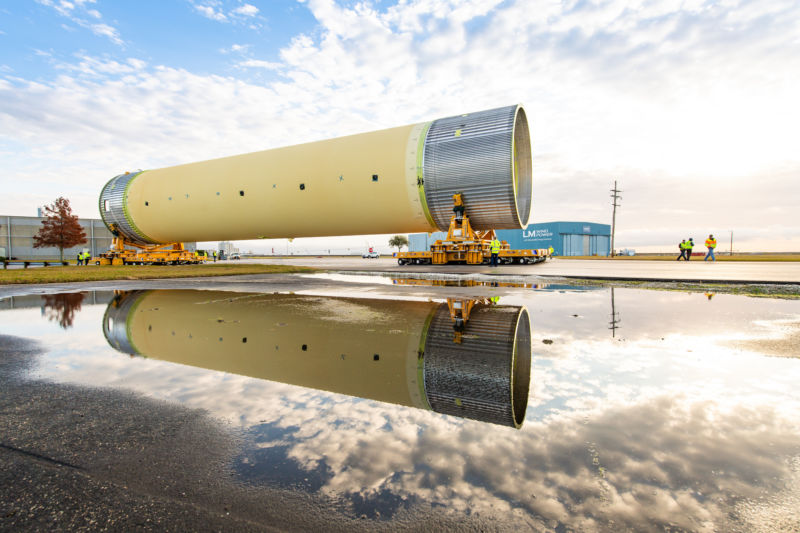
NASA/Steven Seipel
After the Senate Appropriations Committee launched its fiscal 12 months 2020 finances invoice in September, the White Home Workplace of Administration and Finances responded with a letter to share some "further views" on the method. This letter (see a copy), dated October 23 and signed by performing director of the White Home finances workplace Russell Vought, gives some perception into NASA's massive Area Launch System rocket.
Congress has mandated that NASA use the extra expensive SLS booster to launch the bold Europa Clipper mission to Jupiter within the early 2020s, whereas the White Home prefers the company to fly on a much-less-expensive industrial rocket. In a bit discussing the Clipper mission, Vought's letter features a price estimate to construct and fly a single SLS rocket in a given 12 months—greater than $2 billion—which NASA has not beforehand specified.
"The Europa mission may very well be launched by a industrial rocket," Vought wrote to the chairman of the Senate Appropriations Committee, Alabama Republican Richard Shelby. "At an estimated price of over $2 billion per launch for the SLS as soon as improvement is full, the usage of a industrial launch automobile would offer over $1.5 billion in price financial savings. The Administration urges the Congress to supply NASA the pliability known as for by the NASA Inspector Common."
Unbiased estimates have pegged the SLS price this excessive, however NASA has by no means admitted it. A $2 billion price to launch one SLS rocket a 12 months raises vital questions concerning the sustainability of such an exploration program—the federal government killed the equally sized Saturn V rocket within the early 1970s due to equally unsustainable prices.
Marginal versus mounted
The letter additionally references a report revealed by NASA's Inspector Common Paul Martin final Might, which recommended that NASA scientists and engineers, quite than Congress, select the most effective rocket for his or her science mission to Jupiter's Moon Europa. This report, nevertheless, positioned a a lot decrease price estimate on the SLS rocket. It said that, "NASA officers estimate the third SLS Block 1 launch automobile’s marginal price might be a minimum of $876 million."
This discrepancy can seemingly be defined by the distinction between marginal prices and marginal plus mounted prices. Martin's estimate is for "marginal" price alone, that means how a lot it might price NASA to construct a further rocket in a given 12 months. This seemingly doesn't apply to the Europa Clipper mission, nevertheless, as NASA wish to launch the Clipper spacecraft in 2023 or 2024, a time when the SLS rocket's core stage contractor, Boeing, will most likely not be able to constructing a couple of booster a 12 months.
The true price for an SLS rocket ought to due to this fact embrace mounted prices—such manufacturing unit house at NASA's Michoud Meeting in Louisiana, the workforce, and all the different prices past a rocket's steel and different bodily parts. In different phrases, if you're solely able to constructing and flying one rocket a 12 months, the entire worth should embrace mounted and marginal prices, which brings the SLS price to "over $2 billion."
Attending to Jupiter
The political wrangling over the launch automobile has put NASA and the Clipper mission planners on the Jet Propulsion Laboratory in California in a tough place. There are mainly three completely different rides to Jupiter, and every would contain modifications to the spacecraft. To make a 2023 launch, the Clipper's design actually must be locked down quickly.
The highly effective SLS booster gives the quickest journey for the six-ton spacecraft to Jupiter, lower than three years. However for mission planners there are a number of considerations about this rocket past simply its extraordinary price. There's the looming risk that this system might ultimately be canceled (on account of its price, and the emergence of considerably decrease price, privately constructed rockets). NASA's human exploration program additionally has precedence on utilizing the SLS rocket, so if there are manufacturing points, a science mission may be pushed apart. Lastly, there may be the potential for additional developmental delays—vital floor testing of SLS has but to start.
An alternative choice is United Launch Alliance's Delta IV Heavy rocket, which has a superb security document and has launched a number of high-profile missions for NASA. Nevertheless, this rocket requires a number of gravity assists to push the Clipper right into a Jupiter orbit, together with a Venus flyby. This heating would add further thermal constraints to the mission, and scientists would like to keep away from this if in any respect potential.
A last chance is SpaceX's Falcon Heavy rocket, with a kick stage. This booster would take just a little greater than twice so long as the SLS rocket to get the Clipper payload to Jupiter, however it doesn't require a Venus flyby, and due to this fact avoids these thermal points. With a observe document of three profitable flights, the Falcon Heavy additionally avoids among the improvement and manufacturing considerations raised by SLS automobile. Lastly, it gives the bottom price of the three choices.
In the long run, nevertheless, the rocket resolution will most likely not come all the way down to technical and value concerns. Politics, quite, can have the ultimate say. And the Senator to whom Vought's letter was addressed, Richard Shelby (R-Ala.), has championed the SLS rocket for almost a decade. (The automobile is designed and managed at Marshall Area Flight Heart in Alabama, his house state). So for NASA to get its Europa mission, which the science group usually agrees is a excessive precedence as a result of presence of a large water ocean beneath the Moon's icy floor, taxpayers might should pay a further $1.5 billion to placate a strong policymaker.
